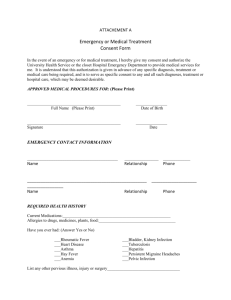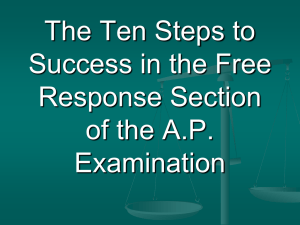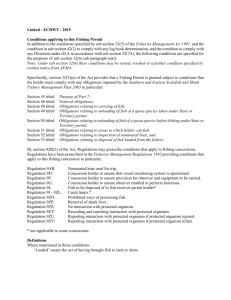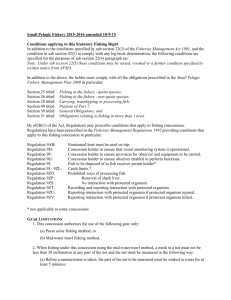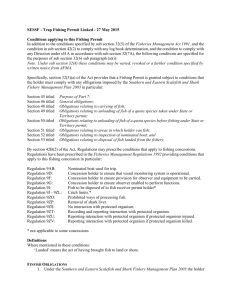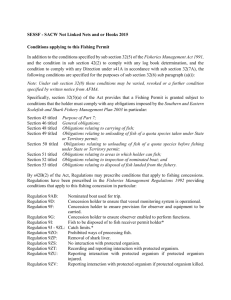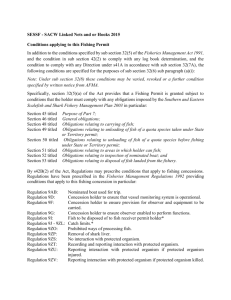Southern and Eastern Scalefish and Shark Fishery Eastern Coastal
advertisement
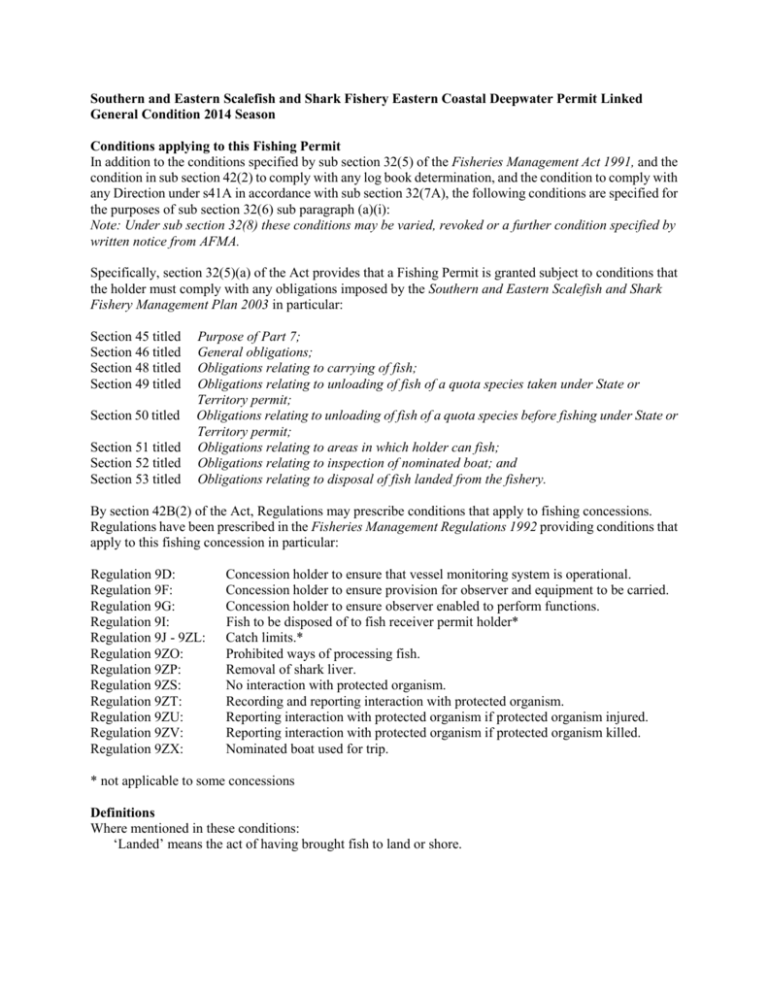
Southern and Eastern Scalefish and Shark Fishery Eastern Coastal Deepwater Permit Linked General Condition 2014 Season Conditions applying to this Fishing Permit In addition to the conditions specified by sub section 32(5) of the Fisheries Management Act 1991, and the condition in sub section 42(2) to comply with any log book determination, and the condition to comply with any Direction under s41A in accordance with sub section 32(7A), the following conditions are specified for the purposes of sub section 32(6) sub paragraph (a)(i): Note: Under sub section 32(8) these conditions may be varied, revoked or a further condition specified by written notice from AFMA. Specifically, section 32(5)(a) of the Act provides that a Fishing Permit is granted subject to conditions that the holder must comply with any obligations imposed by the Southern and Eastern Scalefish and Shark Fishery Management Plan 2003 in particular: Section 45 titled Section 46 titled Section 48 titled Section 49 titled Section 50 titled Section 51 titled Section 52 titled Section 53 titled Purpose of Part 7; General obligations; Obligations relating to carrying of fish; Obligations relating to unloading of fish of a quota species taken under State or Territory permit; Obligations relating to unloading of fish of a quota species before fishing under State or Territory permit; Obligations relating to areas in which holder can fish; Obligations relating to inspection of nominated boat; and Obligations relating to disposal of fish landed from the fishery. By section 42B(2) of the Act, Regulations may prescribe conditions that apply to fishing concessions. Regulations have been prescribed in the Fisheries Management Regulations 1992 providing conditions that apply to this fishing concession in particular: Regulation 9D: Regulation 9F: Regulation 9G: Regulation 9I: Regulation 9J - 9ZL: Regulation 9ZO: Regulation 9ZP: Regulation 9ZS: Regulation 9ZT: Regulation 9ZU: Regulation 9ZV: Regulation 9ZX: Concession holder to ensure that vessel monitoring system is operational. Concession holder to ensure provision for observer and equipment to be carried. Concession holder to ensure observer enabled to perform functions. Fish to be disposed of to fish receiver permit holder* Catch limits.* Prohibited ways of processing fish. Removal of shark liver. No interaction with protected organism. Recording and reporting interaction with protected organism. Reporting interaction with protected organism if protected organism injured. Reporting interaction with protected organism if protected organism killed. Nominated boat used for trip. * not applicable to some concessions Definitions Where mentioned in these conditions: ‘Landed’ means the act of having brought fish to land or shore. CONCESSION ON BOARD OBLIGATION 1. This concession or a true copy thereof must be carried on board the boat nominated to this concession at all times whilst on a trip under this concession and must be produced upon demand by an officer appointed under section 83 of the Fisheries Management Act 1991. FINFISH OBLIGATIONS 2. Under the Southern and Eastern Scalefish and Shark Fishery Management Plan 2003 the holder must not take any tuna or tuna-like species as specified below: (a) Fish of the Family Scombridae, except fish of the Genera Scomberomorus, Acanthocybium, Grammatorcynus and Rastrelliger (commonly known as mackerels); and (b) Fish of the Families Istiophoridae (commonly known as marlins) and Xiphiidae (commonly known as billfish). 3. Any take of the following Eastern Tuna and Billfish Fishery quota species is to be taken in accordance with the Eastern Tuna and Billfish Fishery Management Plan 2010: (a) Albacore tuna (Thunnus alalunga) (b) Bigeye tuna (Thunnus obesus) (c) Broadbill Swordfish (Xiphias gladius) (d) Striped marlin (Tetrapturus audax) (e) Yellowfin tuna (Thunnus albacares). 4. For the purposes of the condition imposed by sub-regulation 9ZD(4) of the Fisheries Management Regulations 1992, the concession holder must not possess on the nominated boat, amongst the total limit of 250kg of specified finfish species, any more than 150 kilograms of the single species of Striped Trumpeter (Latris lineata). 5. The holder must not take more than 250 kilograms of Pink Ling (Genypterus blacodes) per calendar day of each trip from waters east of Longitude 147° East within the Southern and Eastern Scalefish and Shark Fishery. SHARK OBLIGATIONS 6. The holder must not retain Harrisson’s Dogfish (Centrophorus harrissoni), Endeavour Dogfish (C. moluccensis), Southern Dogfish (C. zeehaani) and Greeneye Spurdog (Squalus chloroculus). If any of these species are taken alive, they must be returned to the water carefully and quickly. 7. Retained and/or landed School Shark (Galeorhinus galeus) and Gummy Shark (Mustelus antarcticus) must exceed 450 millimetres when measured in a straight line from the middle of the posterior edge of the aftermost gill-slit to the ventral insertion of the caudal fin. 8. The holder must not carry or possess any shark (Class Chondricthyes) dorsal, pectoral, caudal, pelvic or anal fins on board the boat nominated to this concession that are not attached to the shark’s carcass. QUOTA BALANCING OBLIGATIONS 9. a) The holder must not be over quota for any quota species. b) The holder is not considered to be over quota for a species if, within 28 days of landing an amount (by weight) in excess of their uncaught quota recorded in the Register, the holder acquires a further amount of quota for that species which is equal to or greater than the excess. c) If the holder is over quota for any quota species AFMA may suspend this concession in accordance with this condition, pursuant to section 38(1)(c) of the Fisheries Management Act 1991. In deciding whether to suspend or lift the suspension of this concession AFMA must take account of any written explanation from the holder detailing any exceptional circumstances as to why the holder was over quota. d) Any dealing in a quota Statutory Fishing Right by the holder of a boat Statutory Fishing Right or Fishing Permit for the purpose of complying with this condition must be lodged with AFMA duly executed and in the form approved by AFMA, on or before the 28th day from which the excess quota species was landed. For the purpose of determining if the holder is over quota under this condition, any acquisition of quota for a species may only be deemed to have been acquired up to 28 days prior to the date of registration of that acquisition of that quota species. e) If this concession is suspended, unless the holder has acquired and AFMA has then recorded in the Register (but may not deem) an amount of uncaught quota for which the holder is over quota, this concession may, under this condition, again be suspended upon expiration of the earlier suspension. In this condition: Acquire means receiving statutory fishing rights by registering a dealing by which an amount of statutory fishing rights are permanently or seasonally transferred to the holder; and acquisition has a comparable meaning. Quota species has the same meaning as quota species in the applicable management plan for which this concession has been granted and established under the Fisheries Management Act 1991. Over quota means when the holder lands an amount of quota species in excess of the available uncaught amount recorded for that species in the holder’s name on the Register. Register means the Register of Statutory Fishing Rights kept by AFMA pursuant to section 44 of the Fisheries Management Act 1991 OBSERVER/MONITORING OBLIGATIONS 10. When directed by AFMA the holder must: (a) give the AFMA Observer Section at least 72 hours notice of an intention to depart on a fishing trip, by telephone (02 6225 5506, or 0427 016 859) or by email: observers@afma.gov.au; and (b) ensure that the boat does not leave port until: i. AFMA has notified the holder, or a person acting on behalf of the holder, whether it directs that an observer is to be carried on the boat; and ii. if the boat is equipped with electronic monitoring equipment, an electronic monitoring function test has been completed, AFMA has been notified of the result of the test, and AFMA has notified the holder, or a person acting on behalf of the holder, that it is satisfied that the equipment is working correctly. Note 1: These conditions are in addition to the conditions concerning the taking of observers that are prescribed in the Fisheries Management Regulations 1992 (the Regulations). Those conditions are in Schedule 1, Division 3, regulations 9E to 9G Note 2: AFMA may direct under the Regulations that an observer be carried, even if electronic monitoring equipment is installed and is to be operated. AGENT OBLIGATIONS 11. The holder accepts concurrent liability for all conduct by its servants or agents infringing the Fisheries Management Act 1991 (or the Regulations, Management Plans or concession conditions made by virtue of that Act) who may be engaged by the holder to conduct on the holder’s behalf activity under this concession. 12. Liability for the conduct of the holder’s servants or agents arises, even if the conduct may be, or actually is, beyond the scope of the servant or agent’s actual or apparent authority where it is a breach that occurs during the conduct of activity authorised by this concession. 13. The holder may avoid concurrent liability for conduct whilst conducting activity under this concession if, but only if, the holder can establish that the infringing conduct could not possibly have been prevented by any action or precaution that the holder might have reasonably taken. 14. The giving of an indemnity by the servant or agent to the holder for any penalties incurred by the holder, for infringing conduct by the servant or agent is not, of itself, a reasonable precaution to prevent infringing conduct. DIRECTION OBLIGATIONS 15. The holder must comply with any Direction that fishing is not to be engaged in in the fishery, or a particular part of the fishery or during a particular period or periods made under sub section 41A of the Fisheries Management Act 1991. TEMPORARY ORDERS OBLIGATIONS 16. The holder must comply with any Temporary Order made under sub section 43(2) of the Fisheries Management Act 1991 and to the extent that any provision herein is inconsistent with such Temporary Order sub section 43(9) provides that the provision herein is overridden by the Temporary Order until the Temporary Order ceases to have effect. NAVIGATING IN CLOSED ZONES 17. AFMA may suspend this concession in accordance with this condition, pursuant to section 38(1)(c) of the Fisheries Management Act 1991, if it reasonably appears by VMS transmission from the nominated boat, that there is a failure by that boat while in a closed zone for the purposes of regulation 37B of the Fisheries Management Regulations 1992, to meet the exempting provisions of sub regulations 37C(2), or (3) or sub regulation 37D(2) or (3). Such suspension will then continue until the concession holder provides a full written explanation, to the satisfaction of the delegate responsible for issuing that suspension, of the lawful reason for the boat being in that closed zone at that time, or until the expiration of the suspension under sub section 38(2); whichever is the earlier. CONCURRENT CONDITIONS 18. This concession must only be used in conjunction with another concession held by the same holder namely a Southern and Eastern Scalefish and Shark Fishery (SESSF) Trawl Boat Statutory Fishing Right (“that other concession”) such that: (a) The conditions of that other concession apply (to the extent those conditions are not inconsistent and are capable of doing so) as conditions of this concession. (b) A breach, suspension or cancellation of that other concession is a breach, suspension or cancellation of this concession. (c) The conditions of this concession apply (to the extent these conditions are not inconsistent and are capable of doing so) as conditions of that other concession while it is being used in conjunction with this concession. (d) A breach, suspension or cancellation of this concession is a breach, suspension or cancellation of that other concession. AREA LIMITATION 19. The holder must not fish under this concession outside the area of waters described in this document GEAR LIMITATIONS 20. This concession authorises the use of the following gear only: (a) Mid-water trawl, the mesh size of which must not be less than 90 millimetres at any part; (b) Demersal otter trawl when fishing for prawns: the mesh size of which must not be less than 40 millimetres and not greater than 60 millimetres at any part; (c) Demersal otter trawl when fishing for fish other than prawns: i. Mesh size in the wings and the net mouth (shoulders, belly and veranda) not less than 115mm (4 ½ inch). ii. A mesh size of: i. At least 90mm single twine mesh; or ii. Double twine mesh of at least 102mm (4 inch) or greater; or iii. At least 90mm double twine mesh with one or more bycatch reduction devices (d) Danish seine trawl, with a mesh size of not less than 38 millimetres at any part; and (e) Pair trawling, the mesh size of which must not be less than 90 millimetres at any part. In this condition, a bycatch reduction device means a device that allows fish and other animals to escape immediately after being taken in the net and is constructed as follows: a) a single large square mesh (of at least 90 mm) panel in the upper side of the codend bag (of minimum dimensions 15 bars X 20 bars); or b) a single large rotated mesh (of at least 90 mm) panel (called a T90) in the upper side of the codend bag (of minimum dimensions 15 meshes X 18 meshes). 21. For the purposes of fishing under this concession using a net(s), a mesh in a net must be measured in the following way: (a) before a measurement is taken, the part of the net to be measured must be soaked in water for at least 5 minutes; (b) immediately after the net has been soaked the part of the net to be measured must be suspended vertically. The distance between the inside edge of the knot and the inside edge of the knot in the diagonally opposite corner of the mesh immediately above the first knot must be measured; (c) the measurement must be rounded to the nearest 1.6 millimetres; and (d) the average of the 10 measurements must be taken as the size of the mesh in the net. SEABIRD MANAGEMENT PLAN 22. The holder must not use the nominated boat to fish using demersal otter trawl or midwater trawl methods unless a seabird management plan for the boat has been approved by AFMA. 23. This concession may be suspended without further notice to the holder if the nominated boat departs on a fishing trip and a seabird management plan for the boat has not been approved by AFMA. 24. The seabird management plan must: (a) contain mitigation measures to minimise and avoid where possible, the discharge of biological material whilst fishing gear is in the water to avoid interactions with seabirds; and (b) contain measures that require the holder to use physical mitigation devices in a particular manner to avoid interactions with seabirds. 25. For each fishing trip the holder must: (a) carry a copy of the AFMA approved seabird management plan on the nominated boat; (b) strictly comply with the measures and requirements contained in the seabird management plan; (c) ensure each member of the crew on board the nominated boat briefed on the content of the seabird management plan before each fishing trip; and (d) ensure each member of the crew on board the nominated boat complies with the measures and requirements of the seabird management plan. MOVEMENT LIMITATIONS 26. At least 24 hours before the boat is intending to enter the East Coast Deepwater Zone Fishery, if traveling from another Commonwealth fishery, the holder must give notice to AFMA on facsimile (02) 6225 5440 or email monitoring@afma.gov.au containing: (a) (b) (c) (d) Name and distinguishing symbol of the boat; Position of the boat; Estimated time of entry; and Quota sector through which, or to which the boat is intending to travel, if any. 27. Immediately before the boat enters the East Coast Deepwater Zone Fishery, if traveling from another Commonwealth Fishery, another notice must be given to AFMA. The report must include: (a) Quantity of each quota species carried on board the boat; (b) Port or other place at which those fish are intended to be landed; and (c) Estimated time and date those fish are intended to be landed. 28. If the boat has no quota species on board, immediately before the boat enters the East Coast Deepwater Zone Fishery if traveling from another Commonwealth Fishery, then, at each of those times, a report must be given to AFMA declaring in writing that there is no quota species on board the boat. 29. If the boat has quota species on board, immediately before the boat enters the East Coast Deepwater Zone Fishery, if traveling from another Commonwealth Fishery, then the boat must be prepared for an inspection, if requested, by AFMA as follows: (a) All fishing gear must be immediately stowed and secured; and (b) The boat must be: i. taken directly to the port or other place specified by AFMA by the most direct route; and ii.made available for inspection by AFMA at that port or place. All quota species on the boat must be unloaded before fishing commences in any other area of waters. OTHER OBLIGATIONS 30. The holder must provide AFMA with a current emergency contact facility at all times when a nominated boat is being used under this concession. 31. An emergency contact facility must enable AFMA to contact the boat immediately and directly at any time when the boat is at sea, including in the event of an emergency. 32. AFMA must be notified immediately of any change in contact details, by fax sent to (02) 6225 5440 or by email to licensing@afma.gov.au; and the boat must not depart on a fishing trip unless AFMA has been so notified of the change in contact details. Note: The emergency contact facility may take the form of a satellite phone number, or skipper or crew member’s mobile phone number - any number that may be used by AFMA to contact the boat while it is at sea at any time, including in the event of an emergency.


